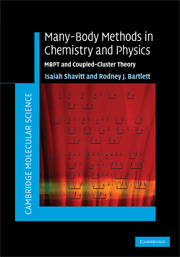Book contents
- Frontmatter
- Contents
- Preface
- 1 Introduction
- 2 Formal perturbation theory
- 3 Second quantization
- 4 Diagrammatic notation
- 5 Diagrammatic expansions for perturbation theory
- 6 Proof of the linked-diagram theorem
- 7 Computational aspects of MBPT
- 8 Open-shell and quasidegenerate perturbation theory
- 9 Foundations of coupled-cluster theory
- 10 Systematic derivation of the coupled-cluster equations
- 11 Calculation of properties in coupled-cluster theory
- 12 Additional aspects of coupled-cluster theory
- 13 The equation-of-motion coupled-cluster method for excited, ionized and electron-attached states
- 14 Multireference coupled-cluster methods
- References
- Author index
- Subject index
13 - The equation-of-motion coupled-cluster method for excited, ionized and electron-attached states
Published online by Cambridge University Press: 06 January 2010
- Frontmatter
- Contents
- Preface
- 1 Introduction
- 2 Formal perturbation theory
- 3 Second quantization
- 4 Diagrammatic notation
- 5 Diagrammatic expansions for perturbation theory
- 6 Proof of the linked-diagram theorem
- 7 Computational aspects of MBPT
- 8 Open-shell and quasidegenerate perturbation theory
- 9 Foundations of coupled-cluster theory
- 10 Systematic derivation of the coupled-cluster equations
- 11 Calculation of properties in coupled-cluster theory
- 12 Additional aspects of coupled-cluster theory
- 13 The equation-of-motion coupled-cluster method for excited, ionized and electron-attached states
- 14 Multireference coupled-cluster methods
- References
- Author index
- Subject index
Summary
Introduction
The conventional, single-reference, coupled-cluster method is very effective for electronic states dominated by a single determinant, such as most molecular ground states near their equilibrium geometry. Such states are predominantly closed-shell singlet states, and CC calculations on them produce pure singlet wave functions. But even these states become dominated by more than one determinant when one or more bonds are stretched close to breaking, so that single-reference CC based on RHF orbitals is then not usually appropriate for the calculation of entire potential-energy surfaces. While such problems can be partially treated by using UHF reference functions, which usually separate correctly, the UHF approach makes use of symmetry breaking and is poor in the spin-recoupling region.
Most excited, ionized and electron-attached states are open-shell states, and CC calculations on them using UHF or ROHF orbitals do not usually result in pure-spin wave functions. Furthermore, such states often involve large contributions from more than one determinant and thus do not respond well to conventional single-reference treatments.
One solution to these problems is to resort to multireference methods, such as those described in Chapters 8 and 14, but such treatments are still quite difficult to apply at a high enough level. An effective alternative in many cases is provided by the equation-of-motion coupled-cluster (EOM-CC) method (Emrich 1981, Sekino and Bartlett 1984, Comeau and Bartlett 1993, Stanton and Bartlett 1993a). A closely related approach is the coupled-cluster linear response (CCLR) method (Monkhorst 1977, Dalgaard and Monkhorst 1983, Koch and Jørgensen 1990).
- Type
- Chapter
- Information
- Many-Body Methods in Chemistry and PhysicsMBPT and Coupled-Cluster Theory, pp. 431 - 461Publisher: Cambridge University PressPrint publication year: 2009



